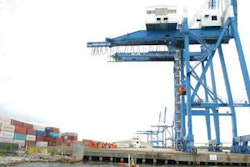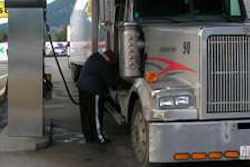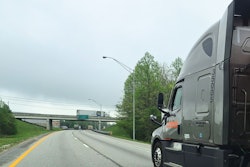FMCSA, after requiring onboard recorders for violation-prone carriers, now seeks a mandate for all OTR operations.
Truckers can comment through April 4 on the Federal Motor Carrier Safety Administration proposal that all interstate commercial truck and bus carriers use electronic onboard recorders to track hours of service. If the mandate is approved, carriers would have three years to comply.
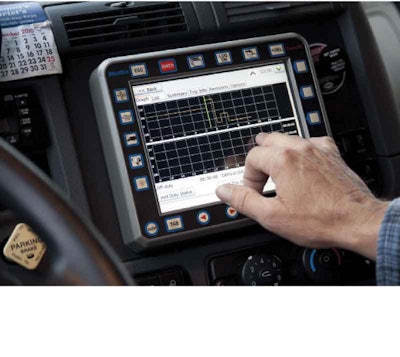 A U.S. Xpress driver calls up information on his dash-mounted EOBR, which the carrier plans to make available companywide.
A U.S. Xpress driver calls up information on his dash-mounted EOBR, which the carrier plans to make available companywide.Under FMCSA’s notice of proposed rulemaking, carriers would be relieved of the requirement to retain certain HOS documents, such as delivery and toll receipts, that are now used to verify logs. Approximately 500,000 carriers would be affected by the rule, FMCSA says.
Interstate carriers that use record of duty status log books would be required to use EOBRs. Short-haul interstate carriers that use timecards to document HOS would not be required to use electronic devices.
Last year, the U.S. Court of Appeals for the District of Columbia ordered FMCSA to issue a notice of proposed rulemaking on HOS supporting documents by yearend, later extending the deadline to Jan. 31. The order stemmed from a lawsuit the American Trucking Associations filed just over a year ago to compel FMCSA to move forward with a regulation as mandated by Congress in the mid-1990s.

By the time ATA filed its lawsuit, FMCSA had already announced it was planning to link new regulations on supporting documents to an expansion of the EOBR mandate. In April 2010, FMCSA issued a final rule requiring carriers with a history of serious log violations to install EOBRs. That rule takes effect in June 2012.
Carriers see EOBRs as an investment in achieving compliance. “We realize law enforcement looks at things like duty status and number of hours for drivers,” says Bob Viso, vice president of safety at U.S. Xpress Enterprises. The carrier has been testing an electronic log system and aims to have all 6,000 of its drivers on the system by the end of 2011. “The system will help drivers comply with those pieces.”
EOBRs are “overpriced record keepers,” says Todd Spencer, executive vice president of the Owner-Operator Independent Drivers Association. “This proposal is actually another example of the administration’s determination to wipe out small businesses by continuing to crank out overly burdensome regulations that simply run up costs.”
OOIDA said EOBRs cannot accurately and automatically record a driver’s hours of service and duty status. They can track only the movement and location of a truck and require human interaction to record any change of duty status.
Sam Mobley, an owner-operator leased to Schneider National, says he’s comfortable with the EOBR. “Once you get used to it and see the simplicity of it and ease of use, you become almost spoiled,” he says. “It makes it so easy. In the van truckload long-haul that I do, I find there is very little restriction it puts on me. It will make you look ahead more, which is good.”
Ricky Gordon, an owner-operator leased to PGT, says a recorder mandate is “a crock of crap. If I own the truck, I ought to be able to do what I want without having the federal government telling me what to do with it. They have to put their hands into everything. It’s an invasion of privacy.”
Cost estimates vary widely
Given today’s product choices, it could cost anywhere from $35 to $2,400 per truck to install electronic onboard recorders to comply with the proposed mandate, according to industry and FMCSA estimates. In addition, customers would pay $30 to $45 per month, possibly less, for data transmission fees.
It appears that how costs are split between carriers and owner-operators also will vary a good bit.
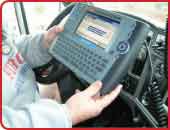 May Trucking Co. charges owner-operators $18.75 a week for its EOBR system that company drivers and owner-operators use. That fee falls short of covering the actual expense of its system, says May’s Cindy Conklin.
May Trucking Co. charges owner-operators $18.75 a week for its EOBR system that company drivers and owner-operators use. That fee falls short of covering the actual expense of its system, says May’s Cindy Conklin.FMCSA’s cost analysis included with the proposed EOBR mandate noted the very expensive ($1,000-plus per truck) devices as being the most commonly available at present. FMCSA’s own cost-benefit analysis of the market doubted that less expensive solutions now available could keep up with production demand for the hardware if the EOBR proposal was realized, even with a delayed compliance date.
The products with the biggest market penetration are produced by PeopleNet and Qualcomm. The basic PeopleNet system costs $900 to $1,100 per truck with a $45 monthly fee. Qualcomm’s systems generally cost more than $1,000.
Most EOBRs are too expensive, says Joel McGinley, president of uDrove, which today sells an electronic logging system that is not a full EOBR. “What’s going to happen is the price point’s going to come way down,” he says. uDrove is developing an EOBR product to be available this summer for less than $100.
Xata already offers its Turnpike RouteTracker program, which does satisfy FMCSA requirements for EOBRs, for $35 monthly in addition to cell data packages. The program enables logging functionality to be added to a PDA or smartphone and uses a small device placed on the dashboard, at no charge to the customer but for a $25 activation fee, to access and store data from the engine ECM.
“Drivers like it because it’s not intrusive,” says company Product Marketing Vice President Christian Schenk. “It’s an app — no different than running Facebook on your Blackberry or iPhone.”
Whatever the cost of the systems, McGinley says carriers and leased owner-operators likely will share the expense in various ways, such as the company paying the hardware expense and charging it back.
Prime Inc., which has been undergoing a fleetwide transition to electronic logs, handled its transition by bearing on the carrier side the large majority of any new charges, says Safety Director Don Lacy. He told Overdrive last year that owner-operators see only some initial cable-replacement charges switching to the new system as long as they’re equipped with one of the fleet’s units. “If they trade their old [Qualcomm] computer in, there’s some charge on that.”
“Schneider National provides the Qualcomm MCP 200 to owner-operators for free because it’s the right thing to do,” says Don Osterberg, vice president of safety at Schneider National. The fleet covers both initial costs and monthly fees.
David Owen, president of the National Association of Small Trucking Companies, calculates mandated EOBRs will cost the industry around $12 billion for installation and $500 million in annual fees and communication costs. “An EOBR is nothing more than an expensive device to ‘game’ CSA and allow a company to appear much safer than they truly are,” he says, arguing that strong compliance scores can deflect attention from crash data.
Avery Vise, Todd Dills and James Jaillet contributed to this report.




